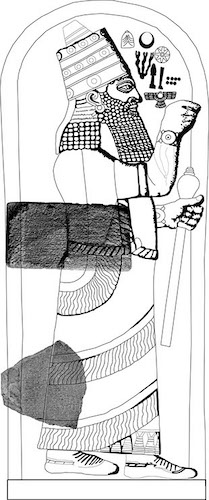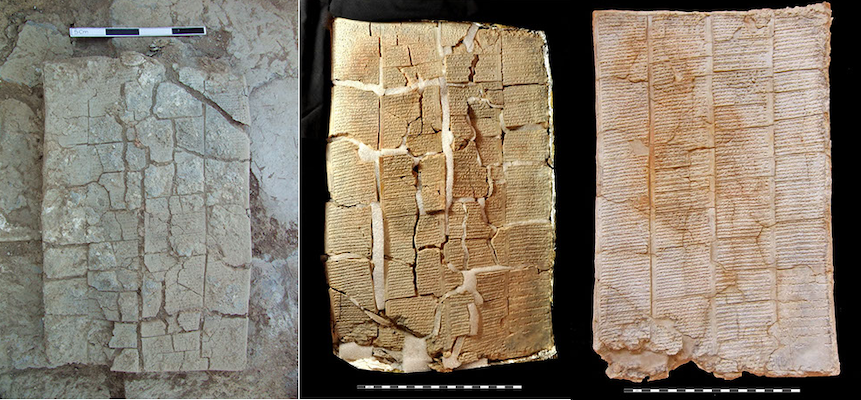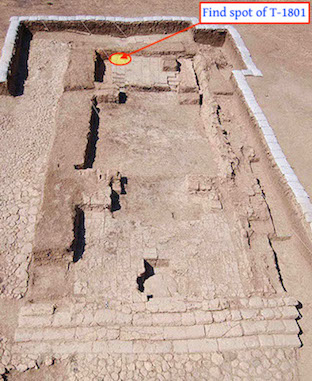You are seeing an unstyled version of this site. If this is because you are using an older web browser, we recommend that you upgrade to a modern, standards-compliant browser such as FireFox [http://www.getfirefox.com/], which is available free of charge for Windows, Mac and Linux.
Neo-Assyrian Archival Texts from Kunalia/Kinalua/Kunulua/Kullania

The city of Kunalia (also written Kinalua, Kunulua, and Kullania; Biblical Calneh) corresponds to the archaeological site of Tell Tayinat. In the early first millennium BC, it was the capital of the kingdom of Pattin, which was also known as Pattin (earlier Palistin). This small state took up the area of the modern Hatay province in Turkey and extended between the Mediterranean coast and the lower reaches of the Orontes river. Unqu / Pattin was conquered by Tiglath-pileser III [/saao/aebp/essentials/kings/tiglatpileseriii/index.html] in 738 BC, and turned into the new Assyrian province of Kunalia, with that city serving as the provincial capital. A governor of Kunalia served as the year eponym only once, during the reign of Sennacherib [/saao/knpp/essentials/sennacherib/index.html] (r. 704–681 BC), specifically in the year 684 BC [/atae/Q004243.234]. The province of Kunalia is further mentioned in administrative texts from the time of Sargon II [/saao/aebp/essentials/kings/sargonii/index.html] (r. 721–705 BC: SAA 7 80; SAA 7 116; SAA 11 6; CTN 3 86 [/atae/P335880,P335781,P336205,P224658]) and in letters from the royal correspondence of Esarhaddon [/saao/knpp/essentials/esarhaddon/index.html] (r. 680–669 BC: SAA 13 86 [/atae/P334248]) and Ashurbanipal [/saao/knpp/essentials/assurbanipal/index.html] (r. 668–631 BC: SAA 10 96 [/atae/P333995]).

Reconstruction of the extremely fragmentarily preserved stele of Sargon II (Sargon II 108 [/rinap/Q006589]), with photographs of two of the excavated fragments. Photo credit: Tayinat Archaeological Project [https://tayinat.artsci.utoronto.ca/the-toronto-expedition/the-sargon-stele/].
Tell Tayinat was first excavated by a team from the Oriental Institute of the University of Chicago between 1935–38 [https://oi.uchicago.edu/research/projects/amuq/tell-tayinat]. A key find was the extremely fragmentarily preserved stele of Sargon II (Sargon II 108 [/rinap/Q006589]). Since 2004, a Canadian team, led by Tim Harrison (University of Toronto), has been excavating at Tell Tayinat [https://tayinat.artsci.utoronto.ca/]. In addition to rich materials from the time of the kingdom of Unqu, these excavations have brought to light a small temple ("Building XVI") constructed during the time when the city was an Assyrian provincial capital. Inside this shrine, a manuscript of Esarhaddon's succession treaty of 672 BC (SAA 2 15 [/atae/kunalia/P500551]) was found in 2009, next to a pedestal that seems to have been used for the tablet's formal presentation. Like the manuscripts of that composition that have been found at the Nabû temple of Kalhu (SAA 2 6 [/atae/Q009186]), the large tablet in portrait format is inscribed in such a way that, when stood on its shorter side, the text on the obverse and the reverse can be read. This is unique to the manuscripts of Esarhaddon's succession treaty as all other Neo-Assyrian clay tablets require to be turned around along their horizontal axis in order to read their reverse.
With the treaty of 672 BC, Esarhaddon had imposed an oath of loyalty on all his subjects, in the provinces and the client states alike, on the occasion of the appointment of his son Ashurbanipal as crown prince. The Kunalia manuscript is the first known text to document the version of this oath as sworn in the Assyrian provinces – over seventy at the time. The manuscripts from Kalhu, of which there are at least nine, document the oath as imposed on the rulers of the client states of the Assyrian Empire on behalf of their people. There is also a small fragment of a manuscript from Assur that is too incomplete to allow more than its identification as a version of the succession treaty.
Although the treaty was conducted between Esarhaddon and a provincial governor or a client ruler, the Assyrian king did so as the representative of the god Aššur whose three seals were impressed on all manuscripts. They were identified as such in a caption inscribed above the seal impressions that was designed to emphasise their powerfully binding nature:
How integral the connection between the tablets, their sealings and the god Aššur was is made explicit in a clause that is best preserved in the manuscript from Kunalia:

Photographs of T-1801, Esarhaddon's succession treaty, in situ (left), before conservation (middle), and after conservation (right). Photo credit: Tayinat Archaeological Project [https://tayinat.artsci.utoronto.ca/the-toronto-expedition/the-esarhaddon-succession-treaty/].
That these tablets were indeed displayed and considered the object of worship is demonstrated by the architectural context in which the Kunalia manuscript has been found. In addition to that text, the shrine also housed an assortment of other clay tablets: several copies of the hemerology Iqqur īpuš (at least one of which was in the shape of an amulet) as well as a manuscript of the lexical list UR₅-ra = hubullu, and an administrative docket (currently still awaiting publication). For further information about these texts, see:

Aerial photo of Temple XVI after its excavation in 2009, with the find spot of clay tablet T-1801, which is inscribed with a copy of Esarhaddon's cuccession treaty. Photo credit: Tayinat Archaeological Project [https://tayinat.artsci.utoronto.ca/the-toronto-expedition/temple-xvi/].
- Timothy P. Harrison/James F. Osborne, "Building XVI and the Neo-Assyrian Sacred Precinct at Tell Tayinat," [https://www.jstor.org/stable/10.5615/jcunestud.64.0125] Journal of Cuneiform Studies 64 (2012), 125-143.
- Jacob Lauinger, "Some Preliminary Thoughts on the Tablet Collection in Building XVI from Tell Tayinat," [http://sites.utoronto.ca/tap/assets/lauinger-csms_2011.pdf] Journal of the Canadian Society for Mesopotamian Studies 6 (2011), 5–14.
- Jacob Lauinger, "Esarhaddon's Succession Treaty at Tell Tayinat: Text and Commentary," [https://www.jstor.org/stable/10.5615/jcunestud.64.0087] Journal of Cuneiform Studies 64 (2012), 87–123.
- Jacob Lauinger, "Iqqur īpuš at Tell Tayinat," [https://www.jstor.org/stable/10.5615/jcunestud.68.2016.0229] Journal of Cuneiform Studies 60 (2016), 229–248.
This sub-project of the Archival Texts of the Assyrian Empire (ATAE) [/atae/] Project includes an annotated (lemmatized), open-access version of the copy of Esarhaddon's succession treaty that was discovered at Kunalia. The edition was adapted by Mikko Luukko from Jacob Lauinger, "Esarhaddon's Succession Treaty at Tell Tayinat: Text and Commentary," Journal of Cuneiform Studies 64 (2012), 87–123.
Click here [/atae/kunalia/P500551] to access the Tell Tayinat copy of Esarhaddon's Succession Treaty.
ATAE is a key component of the Archival Texts of the Middle East in Antiquity (ATMEA) sub-project of the LMU-Munich-based Munich Open-access Cuneiform Corpus Initiative [https://www.en.ag.geschichte.uni-muenchen.de/research/mocci/index.html] (MOCCI; directed by Karen Radner and Jamie Novotny). Funding for the ATAE corpus project has been provided by LMU Munich and the Alexander von Humboldt Foundation (through the establishment of the Alexander von Humboldt Chair for Ancient History of the Near and Middle East).
For further details, see the "About the project" [/atae/abouttheproject/index.html] page.

Home Page banner credit
Aerial view of Tell Tayinat. Photo Credit: Murat Akar - Tayinat Archaeological Project [https://tayinat.artsci.utoronto.ca/]. This image is licensed under the Creative Commons Attribution-Share Alike 4.0 International license.